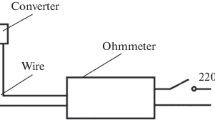Abstract
Experimental data for carbon–carbon constituent materials are combined with a three-dimensional stationary heat-transfer finite element analysis to compute the average transverse and longitudinal thermal conductivities in carbon–carbon composites. Particular attention is given in elucidating the roles of various micro-structural defects such as de-bonded fiber/matrix interfaces, cracks and voids on thermal conductivity in these materials. In addition, the effect of the fiber precursor material is explored by analyzing PAN-based and pitch-based carbon fibers, both in the same type pitch-based carbon matrix. The finite element analysis is carried out at two distinct length scales: (a) a micro scale comparable with the diameter of carbon fibers and (b) a macro scale comparable with the thickness of carbon–carbon composite structures used in the thermal protection systems for space vehicles. The results obtain at room temperature are quite consistent with their experimental counterparts. At high temperatures, the model predicts that the contributions of gas-phase conduction and radiation within the micro-structural defects can significantly increase the transverse thermal conductivity of the carbon–carbon composites.










Similar content being viewed by others
Abbreviations
- α:
-
Thermal accommodation factor
- C p :
-
Solid-phase mass heat capacity
- d :
-
Gas collision diameter
- δ:
-
Characteristic length scale for gas molecules in the porous medium
- ɛ:
-
Emissivity
- K B :
-
Boltzmann’s constant
- Kn :
-
Knudsen number
- k :
-
Thermal conductivity
- λ:
-
Gas molecular mean field path
- P :
-
Pressure
- Pr :
-
Prandtle number
- q :
-
Heat flux
- ρ:
-
Density
- σ:
-
Stefan–Boltzmann constant
- T :
-
Temperature
- x, y, z :
-
Spatial coordinates
- x−y :
-
Quantity in the transverse plane
- high:
-
Graphene in-plane quantity
- low:
-
Graphene out-of-plane quantity
- matrix:
-
Matrix-phase quantity
- fiber:
-
Fiber-phase quantity
- gas:
-
Gas-phase quantity
- r:
-
Radiation related quantity
References
Buckley JD, Edie DD (1993) Carbon–carbon materials and composites. William Andrew Publishing/Noyes, New York, NY
Ohlhorst CW, Vaughn WL, Ransone PO, Tsou H-T (2004) Thermal conductivity database of various structural carbon–carbon composite, Materials, NASA Technical Memorandum 4787. National Aeronautics and Space Administration, Langley Research Center, Hampton, Virginia, pp 23681–24199
Klett JW, Ervin VJ, Edie DD (2005) Compos Sci Technol 227:56
Sullins AD, Daryabeigi K (2001) Effective thermal conductivity of high porosity open cell nickel foam. AIAA pp 2001–2819, 11–14 June
Grujicic M, Zhao CL, Biggers SB, Kennedy JM, Morgan DR (2004) Mater Sci Eng A, submitted for publication, June 2004
www.comsol.com, FEMLAB 3.0a, COMSOL Inc., Burlington, MA 01803, 2004
MATLAB, 6th ed. (2003) The language of technical computing. The MathWorks Inc., 24 Prime Park Way, Natick, MA, 01760–1500
Grujicic M, Chittajallu KM (2004) Appl Surf Sci 227:56
Blosser M (May, 2000) Advanced metallic thermal protection systems for reusable launch vehicles, Ph.D. Dissertation, University Of Virginia
Morgan DR (2001) Coal based carbon foam for high temperature applications. MS thesis, University of North Texas, Denton, Texas
Acknowledgements
The material presented in this paper is based on work sponsored by the U.S. Air Force through Touchstone Research Laboratory, Ltd. The authors acknowledge valuable discussions with Professors Don Beasley, Richard Miller and Jay Ochterbeck of Clemson University.
Author information
Authors and Affiliations
Corresponding author
Rights and permissions
About this article
Cite this article
Grujicic, M., Zhao, C.L., Dusel, E.C. et al. Computational analysis of the thermal conductivity of the carbon–carbon composite materials. J Mater Sci 41, 8244–8256 (2006). https://doi.org/10.1007/s10853-006-1003-x
Received:
Accepted:
Published:
Issue Date:
DOI: https://doi.org/10.1007/s10853-006-1003-x




